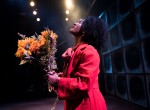“The Long Christmas Ride Home” cast members did wall sits and pushups in preparation for their latest role: puppeteering.
Students from UCLA School of Theater, Film and Television will perform in playwright-in-residence Paula Vogel’s “The Long Christmas Ride Home” on Wednesday. The play tells the story of three children on a road trip with their parents during the Christmas season. At one point during their journey, the father slaps the mother, and the rest of the performance recounts the ways in which witnessing the violent act impacts the children in their adult lives. The 90-minute show features both live actors and Japanese bunraku-inspired puppets in an attempt to explore the ways in which people relive memories, said Dominic Taylor, the show’s director.
“The thing about the puppets is that they are our memory in motion,” he said. “The nature of theater is to construct this thing that is invariably ephemeral – it’s gone as soon as it’s made, but the puppets allow us to have objects that don’t go.”
The mother and father characters are performed by actors, while the children are initially only seen as puppets – however as the play progresses and the children age, actors come on stage and perform simultaneously with the puppets.
The puppets serve as the play’s central semiotic tool, helping the audience fully understand the show’s emphasis on memory and familial relations, Taylor said. When the puppets and people are simultaneously onstage, Taylor said he feels the puppets naturally attract the audience’s attention. He also said the puppets work to monumentalize the characters, similar to a photograph or a statue – but in motion.
“It’s a really interesting thing if you look at an old photo when you were 8 years old – but what if you could see not just a model of you, but a model of you that engages in the (same) behavior … and doesn’t age,” he said.
The puppets, designed by fourth-year theater student Yi Lin Zhao, are not proper bunraku puppets – the script emphasizes the fact that, while they are inspired by the Japanese puppetry form, they are to be differentiated from traditional bunraku puppets. To remain conscious and sensitive of cultural appropriation, Taylor said he had the puppeteers study the history and art of bunraku puppetry and prepare a presentation on it for the rest of the cast members.
Aiko Little, one of the puppeteers manipulating the youngest daughter Claire’s puppet, said the setup of the production aims to stress the differences between the production’s puppets and actual bunraku puppets. For example, while she said traditional bunraku puppets have three people controlling them, there are usually only two puppeteers controlling most of the puppets in the TFT production.
“One of the questions that came up at the very, very beginning of the rehearsal process was ‘What is the line that we draw so that rather than it being appropriating, it’s appreciating,’ and also just making sure we’re still distancing ourselves from bunraku itself,” said the third-year theater student.
Zhao said she used 3D-printed replicas of the actors’ heads to create the faces of the puppets – another stylistic departure from traditional bunraku puppets, which were developed in 17th-century Japan. Little added that the puppets also wear articles of clothing typical of American fashion, such as a bright red coat and a gray knit beanie.
Riva Brody, a second-year theater student and the other puppeteer who manipulates Claire, said she ultimately hopes the show facilitates thought and dialogue surrounding the way our childhoods can shape the way we lead our lives as adults.
Throughout the process of working with the puppets, Brody said the show has allowed her to examine the ways in which her current choices as a college student can impact her life in the future. Looking toward the opening of the show, Taylor said he hopes the audience can feel something similar, reflecting on their memories and using them as a means to better themselves.
“I want people to go and have an experience that they’ve never had before,” he said. “I’d like people to take their memories (and) realize that you can take your memory, reposition it, and hopefully do something really positive and proactive … with it.”
